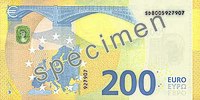
Back ورقة 200 يورو Arabic ২০০ ইউরো নোট Bengali/Bangla Bitllet de dos-cents euros Catalan 200-Euro-Banknote German Χαρτονόμισμα 200 ευρώ Greek Billete de doscientos euros Spanish 200-eurone rahatäht Estonian Billet de 200 euros French Billete de 200 euros Galician Uang 200 Euro ID
| (European Union[1]) | |
|---|---|
| Value | 200 euro |
| Width | 153[2] mm |
| Height | 82 (1st series) 77 (Europa series)[2] mm |
| Security features | Hologram patch with perforations, EURion constellation, watermarks, microprinting, ultraviolet ink, raised printing, security thread, matted surface, see through number, colour-changing ink, barcodes and serial number[3] |
| Material used | Cotton fibre[3] |
| Years of printing | 1999–2018 (1st series)[4] Since 2018 (Europa series)[4] |
| Obverse | |
 | |
| Design | Window in an Art Nouveau style[5] |
| Designer | Robert Kalina[6] |
| Design date | 17 September 2018[6] |
| Reverse | |
 | |
| Design | Bridge in an Art Nouveau style and map of Europe[5] |
| Designer | Robert Kalina[6] |
| Design date | 17 September 2018[6] |
The two hundred euro note (€200) is the second highest value euro banknote (and the highest value banknote in production) and has been used since the introduction of the euro (in its cash form) in 2002.[7] The note is used in the 26 countries that have the euro as their sole currency (with 24 legally adopting it); with a population of about 343 million.[8] In July 2023, there were about 849,000,000 €200 banknotes in circulation around the eurozone. It is the second least widely circulated denomination, accounting for 2.9% of the total banknotes.[9]
It is the second-largest note, measuring 153 × 82 mm, and the first series has a yellow colour scheme and the second series has a brown colour scheme.[5] The two hundred euro banknotes depict bridges and arches/doorways in Art Nouveau style (19th and 20th centuries). The €200 note contains several complex security features such as watermarks, invisible ink, holograms and microprinting that document its authenticity.
The new banknotes of the Europa series 200 euro banknote was released on 28 May 2019.[10]
- ^ Institutions and the members of the Eurozone
- ^ a b "ECB: Security Features". ECB. 11 September 2018. Retrieved 23 October 2011.
- ^ a b "ECB: Security Features". European Central Bank. ecb.int. 2002. Archived from the original on 2012-08-30. Retrieved 22 October 2011.
- ^ a b "ECB: Introduction". ECB. 12 November 2020. Retrieved 21 October 2011.
- ^ a b c "ECB: Banknotes". European Central Bank. 2002. Retrieved 13 October 2011.
- ^ a b c d "ECB: Banknotes design". ECB. February 1996. Retrieved 13 October 2011.
- ^ "Witnessing a milestone in European history". The Herald. Back Issue. 1 January 2002. Archived from the original on 1 August 2018. Retrieved 23 October 2011.
- ^ * "Andorran Euro Coins". Eurocoins.co.uk. 2003. Archived from the original on 16 August 2012. Retrieved 15 October 2011.
- "By UNMIK administration direction 1999/2". Unmikonline.org. 4 October 1999. Archived from the original on 7 June 2011. Retrieved 30 May 2010.
- "By monetary agreement between France (acting for the EC) and Monaco". 31 May 2002. Retrieved 30 May 2010.
- "By monetary agreement between Italy (acting for the EC) and San Marino". 27 July 2001. Retrieved 30 May 2010.
- "By monetary agreement between Italy (acting for the EC) and Vatican City". 25 October 2001. Retrieved 30 May 2010.
- "ECB: Map of euro area 1999 – 2011". ECB. ecb.int. 1 January 2011. Retrieved 27 October 2011.
- "Total population as of 1 January". Epp.eurostat.ec.europa.eu. 2011-03-11. Archived from the original on 20 July 2011. Retrieved 2011-07-17.
- ^ "ECB Statistical Data Warehouse,Reports>ECB/Eurosystem policy>Banknotes and coins statistics>1.Euro banknotes>1.1 Quantities". ECB. European Central Bank.
- ^ ECB unveils new €100 and €200 banknotes
© MMXXIII Rich X Search. We shall prevail. All rights reserved. Rich X Search